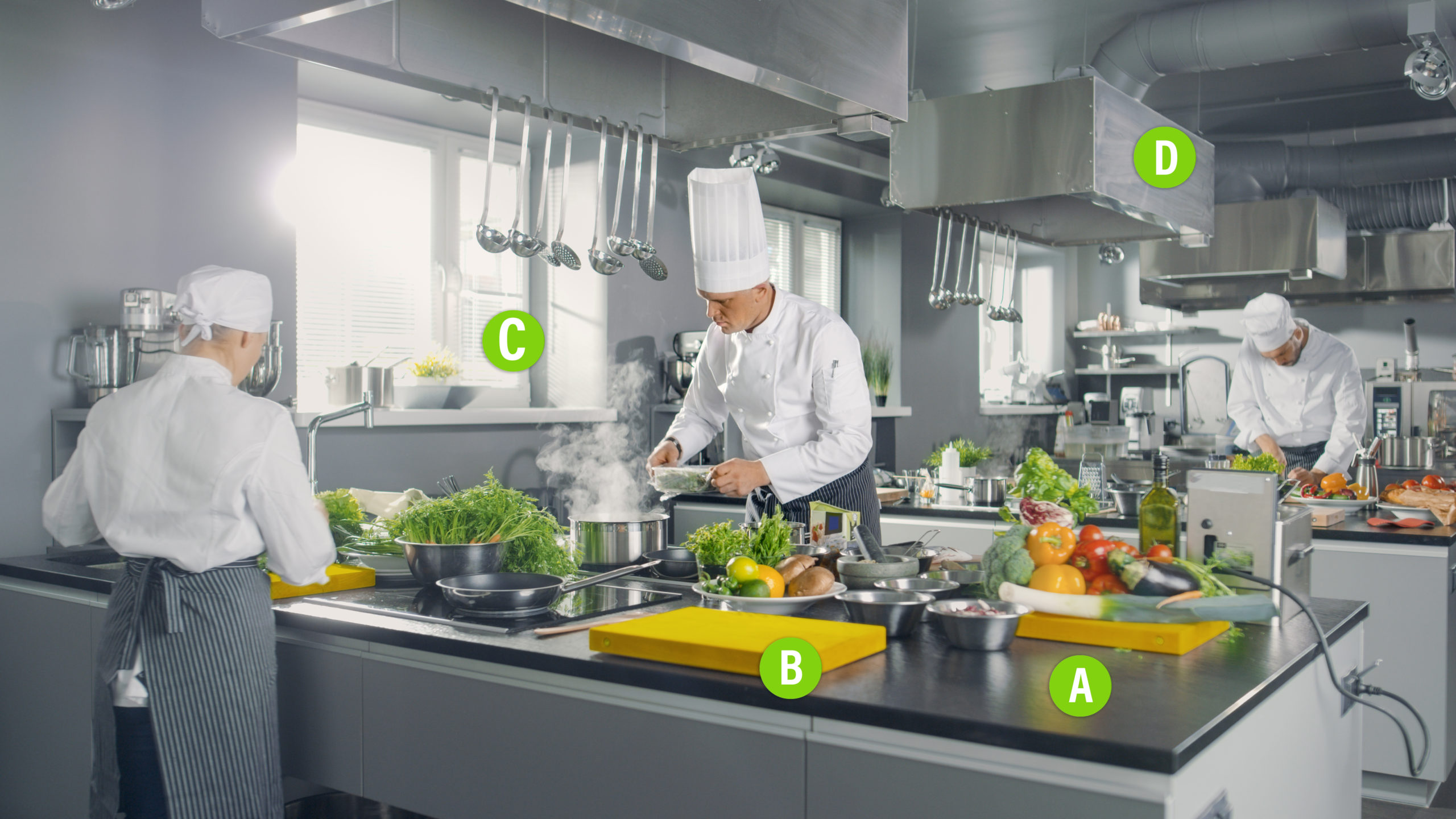With the current pandemic situation, the restoration sector has made a great effort to adapt its facilities with additional safety, hygiene, and health measures (hydroalcoholic gel, safety distances between tables, menus with QR codes, disinfection devices, improvements in ventilation, filters, temperature control…). There are other measures that can contribute to the biosecurity of professional kitchens: Passive Food Safety Systems (PFSS).
Passive Food Safety Systems (PFSS) are all those technological utilities that, when applied in professional kitchens and related sectors, help to provide a safer food processing space. PFSS are a management tool and a hallmark of food safety systems based on:
- Design
- Materials, equipment, and tools
- Processes and procedures
Although food safety has traditionally been largely the responsibility of food handlers – in their own health and training, in the implementation of hygienic procedures and in self-monitoring processes – the role that the design of the space and especially the materials and equipment of professional kitchens play in the safety of the final product should not be underestimated.
In relation to this aspect, Passive Food Safety Systems (PFSS) focus on materials, equipment, and tools, providing the latest generation systems that provide additional safety and hygiene against possible microbiological contamination.
Professional kitchens incorporate materials and equipment that improve their level of safety and hygiene. It is no longer enough just to clean and disinfect a kitchen, but from its origin it must be conceived as a healthy space, facilitating not only cleaning and hygienic practices, but also incorporating advanced systems to protect against biological contamination.
It has been more than 10 years since Maite
Pelayo, microbiologist and food safety specialist, developed the idea of PFSS for
the Silestone Institute. SPSA concept is in continuous evolution to
incorporate new systems and safety mechanisms in professional kitchens.
Some of them are:
- Latest
generation materials and coatings
- Hygienic materials and surfaces that contribute to prevent the proliferation of microorganisms.
- Prevention of biofilms: surface sensors and biosensors.
- Refrigerators and other household appliances:
- Refrigerators with internal coating including bacterial growth limiting silver particles.
- Independent refrigeration circuits that prevent the transmission of microorganisms between refrigerators and freezers.
- Dishwashers with antibacterial parts for greater protection.
- Kitchen tools and utensils
- Cross-contamination cutting boards color-coded according to the type of product (working lines).
- Knives and tools with antimicrobial treatments.
- Other systems
- Automatic soap and water dispensers with sensor.
- High-speed micro-current air dryers.
- Hygienic waste receivers with infrared technology.
- Air purifiers and filtration units that reduce the microbiological load of the environment.
- Extractor hoods and environmental control systems that prevent biohazardous temperatures and humidity.
- Furniture: treated with antibacterial varnish that guarantees unlimited coverage. The sanitizing components do not wear off with daily cleaning or time, but last for the entire life of the furniture. It does not alter the characteristics of the materials and is totally free of toxic components for human contact.
- Textiles: with anti-mildew, anti-virus, and anti-bacterial treatments. Color-coded cloths to avoid cross-contamination.
- Cleaning and disinfection: cleaning and hygiene utensils that must also be sanitized but are equipped with additives that prevent the massive proliferation of microorganisms.
- Digital PFSS: IT tools and digital technologies that
increase food safety:
- Interconnected kitchens: internet of things (smart refrigerators equipped with touch screen with food vision without opening -facilitates uniform temperature control-, stock management and shelf life…).
- Refrigeration is a field of intense application in “Internet of Things” and “Cloud Computing” (autonomous decision making). Artificial Intelligence (learning from experience automatically) optimally manages resources in refrigeration ensuring the SA of products.
- Blockchain technology, the new traceability tool.
- Mobile devices such as PDAs (small pocket computers) that record the entry of food into the pantry by reading the barcode with infrared and thus store important information such as the expiration date of each product.
- Intelligent technology for customized cleaning and disinfection: packages of automatic cleaning tools connected online, traceability and management of services with real-time information, application of QR codes…
- Some of these SPSAs also have the added value of being management systems against food wastage.
Within the New Paradigm of Food Safety, which considers not only the effect of food on our organism (sensory, nutritional, sanitary…) but also our impact on food safety, PFSS must meet other requirements, mainly related to:
- Sustainable production: low impact on the environment.
- Recycling of component materials (especially plastics and microplastics) within circular economy processes.
For more information on PFSS, see their technical notebook: https://silestoneinstitute.com/wp-content/uploads/2019/08/SPSA_ENG_2.pdf

